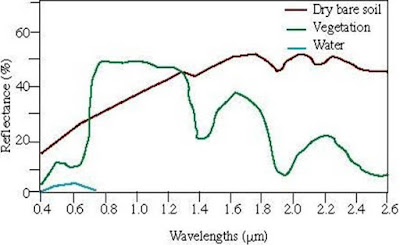This article is prepared to understand the role of reflectance and spectral signature in a satellite image. How the reflectance vary with change in EMR and characteristics of earth surface feature.
It is very important to understand that how the reflection which is received by sensor, converts into an image. It is explained in earlier article that how the reflectance taking place and its behavior of incident energy after interaction with surface.
The reflectance completely depends on incident energy and characteristics of material/earth’s surface feature. So reflectance which is created during this process is called SIGNATURE.
Every object on the earth surface reflects and emits incident radiation is defined as signature of that object. It can be also called re-radiation from earth surface feature. These signatures are recorded by sensor boarded on satellites.
As it is understood that basically only three natural land covers, it includes vegetation, soil and water. So behavior of these three natural covers with incident energy will create reflectance. Which is further, defined as signature of these land covers. This signature pattern can be understood by the spectral signature curve, which is in below figure.
Typical Spectral Reflectance Curve of Soil, Water and Vegetation
Vegetation:
The reflectance received in the range from about 0.7 to 1.3 μm from vegetation and it reflects typically 40 – 50% of the energy incident uponit. The reflectance from vegetation depends upon internal structure of leaf and condition of plant.
There are lots of variations in reflectance value as reflectance values goes down in these wavelengths at 1.4, 1.9 and 2.7 μm and reflectance peaks occur at about 1.6 μm and 2.2 μm.
Soil:
The reflectance of soil is influenced by many factors such as moisture content, soil texture (proportion of sand, silt and clay), surface roughness, presenceof iron oxide and organic matter content. So it is understood that dry soil will have more reflectance compare to moisture soil. Soil reflectance is higher in 1.4 to 1.8 and 2.0 to 2.1 wavelengths, whereas in blue part of visible spectrum have lowest reflectance compare to other part of spectrum.
Water:
Reflectance in water is limited to visible part, where as radiation is absorbed in IR wavelengths of spectrum. Clear water body absorbs comparatively less energy, results in high transmittance. However turbidity in water affects the reflectance. Reflectance from a water body is dependent on
- the type of water surface (specular reflection),
- suspended material present in the water
- depth of the water body
The ultimate reflectance, after interaction of incident energy with the earth surface feature is received by satellite sensor. This Reflectance is recorded and converts into an image.

Nice